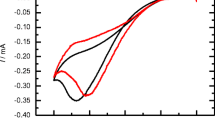Abstract
The interaction of Pt(II)(dppf)-complex, namely [Pt(dppf)(H2O)2]2+ with DNA was investigated by DPV and 1H-NMR techniques. The results showed that the interaction process has been characterized by changes in the electrochemical parameters of both compounds and the formation of a new anodic current peak close to the anodic current peak of the [Pt(dppf)(H2O)2]2+. In addition, the 1H-NMR spectra show that the coordination of Pt(II)(dppf)-complex to dsDNA occurs via N(7) of guanine. Others parameters like pH and ionic strength that affect the interaction process were also investigated.






Similar content being viewed by others
References
Aslanoglu M, Isaac CJ, Houlton A, Horrocks BR (2000) Voltammetric measurements of the interaction of metal complexes with nucleic acids. Analyst (Lond) 125:1791–1798. doi:10.1039/b005440m
Bjelosevich H, Spegel C, Snygg AS, Gorton L, Elmroth SKC, Persson T (2006) Synthesis and structural characterization of novel platinum-based drug candidates with extended functionally by incorporation of bis (diphenylphosphino) ferrocene units as metal chelators. Tetrahedron 62:4519–4527. doi:10.1016/j.tet.2006.02.057
Brabec V, Kasparkova J (2005) Modifications of DNA by platinum complexes. Relation to resistance of tumors to platinum antitumor drugs. Drug Resist Update 8:131–146. doi:10.1016/j.drup.2005.04.006
Collins JG, Wheate NJ (2004) Potentical adenine and minor groove binding platinum complexes. J Inorg Biochem 98:1578–1584. doi:10.1016/j.jinorgbio.2004.04.021
Cullen WR, Woollins JD (1981) Ferrocene-containing metal complexes. Coord Chem Rev 39:1–30. doi:10.1016/S0010-8545(00)80510-X
Han WS, Kim YJ, Lee SW (2003) Reactivity of [Pt(dppf)Cl2] toward simple organic thiolates: preparation and structures of [Pt(dppf)(SPh)2], [Pt(dppf)(S-n-Pr)2] and [Pt(dppf)(SCH2CH2CH2S)](dppf = Fe(η5-C5H4PPh2)2). Bull Korean Soc 24:60–64
Hayashi T, Konishi M, Kobori Y, Kumada M, Higuchi T, Hirotsu K (1984) Dichloro [1,1′-bis (diphenylphosphino)ferrocene] palladium (II): an effective catalyst for cross-coupling of secondary and primary alkyl Grignard and alkylzinc regents with organic halides. J Am Chem Soc 106:158–163. doi:10.1021/ja00313a032
Kennard O (1993) DNA–drug interactions. Pure Appl Chem 65:1213–1222. doi:10.1351/pac199365061213
Kostova I (2006) Platinum complexes as anticancer agents. Recent Pat Anticancer Drug Discov 1:1–22. doi:10.2174/157489206775246458
Longato B, Pilloni G, Valle G, Corain B (1988) Synthesis and solvolytic behavior of cis [1,1′-bis (diphenylphosphino) ferrocene] platinum (II) and-palladium (II) complexes. X-ray structure of bis-(.mu.-hydroxy)bis [1,1′-bis(diphenylphosphino)ferrocene]diplatinum(II) tetrafluoroborate. Inorg Chem 27:956–958. doi:10.1021/ic00278a043
Lu X, Zhu K, Zhang M, Liu H, Kang J (2002) Voltammetric studies of the interaction of transition-metal complexes with DNA. J Biochem Biophys Methods 52:189–200. doi:10.1016/S0165-022X(02)00074-X
Mason RW, McGrouther K, Bandarage PRR, Robinson BH, Simpson J (1999) Toxicology and antitumor activity of ferrocenylamines and platinum derivates. Appl Organomet Chem 3:163–174. doi:10.1002/(SICI)1099-0739(199903)13:3<163::AID-AOC821>3.0.CO;2-K
Nataro C, Campbell AN, Ferguson MA, Incarvito CD, Rheingold AL (2003) Group 10 metal compounds of 1,1′-bis(diphenylphosphino) ferrocene (dppf) and 1,1′-bis(diphenylphosphino) ruthenocene: a structural and electrochemical investigation. X-ray structures of [MCl2(dppr)] (M = Ni, Pd). J Organomet Chem 673:47–55. doi:10.1016/S0022-328X(03)00155-4
Noh DY, Seo EM, Lee HJ, Jang HY, Choi MG, Kim YH, Hong J (2001) Synthesis and characterization of heterobimetallic complexes (dppf)Pt(dithiolate) (dppf: bis(diphenylphosphino)ferrocene); X-ray crystal structures of (dppf)PtL where L = dmit, phdt and i-mnt. Polyhedron 20:1939–1945. doi:10.1016/S0277-5387(01)00783-5
Petrovic D, Stojimirovic B, Petrovic B, Bugarcic ZM, Bugarcic ZD (2007) Studies of interaction between platinum (II) complexes and same biologically relevant molecules. Bioorg Med Chem 15:4203–4211. doi:10.1016/j.bmc.2007.03.059
Puxty G, Bjelovich H, Persson T, Elmroth SKC (2005) A comparative kinetics study of modified Pt(dppf)Cl-2 complexes and their interactions with l-cys and l-met. Dalton Trans 18:3032–3038. doi:10.1039/b504129e
Sadler PJ, Guo Z (1998) Metal complexes in medicine: design and mechanism of action. Pure Appl Chem 70:863–871. doi:10.1351/pac199870040863
Scarcia V, Furlani A, Longato B, Carain B, Pilloni G (1988) Heteropolymetallic complexes of 1,1′-bis(diphenylphosphino) ferrocene (dppf).IV.solvolytic behavior and cytostatic properties towards the KB cell line of dppf and 1,2-bis(diphenylphosphino) ethane cis-complexes of Pt(II) and Pd(II). Inorg Chim Acta 153:67–70. doi:10.1016/S0020-1693(00)83359-9
Sequaris JM, Kaglin E, Malfoy B (1984) Inner and outer complexes of Pt-coordination compounds with DNA probed by SERS spectroscopy. FEBS Lett 173:95–98. doi:10.1016/0014-5793(84)81024-8
Sherman SE, Lippard SJ (1987) Structural aspects of platinum anticancer drug interactions with DNA. Chem Rev 87:1153–1181. doi:10.1021/cr00081a013
Sistare MF, Holmberg RC, Thorp HH (1999) Electrochemical studies of polynucleotide binding and oxidation by metal complexes: effects of scan rate, concentration and sequence. J Phys Chem 103:10718–10728
Swiatek J (1994) Interactions of metal ions with nucleic acid and their subunits. An electrochemical approach. J Coord Chem 33:191–217. doi:10.1080/00958979408024278
Vrana O, Brabec V (1986) Polarographic studies on the conformation of DNA modified by cis-diammedichloroplatinum (II) and radiation in combination. Stud Biophys 114:209–214
Wang D, Lippard SJ (2005) Cellular processing of platinum anticancer drugs. Nat Rev Drug Discov 4:307–320. doi:10.1038/nrd1691
Acknowledgments
The authors thank FAPESP for the financial support.
Author information
Authors and Affiliations
Corresponding author
Rights and permissions
About this article
Cite this article
Mello, L.D., Ribeiro, E.S., Kubota, L.T. et al. Electrochemical and spectroscopic evidences of the interaction between DNA and Pt(II)(dppf)-complex. Biometals 22, 385–392 (2009). https://doi.org/10.1007/s10534-008-9175-2
Received:
Accepted:
Published:
Issue Date:
DOI: https://doi.org/10.1007/s10534-008-9175-2




